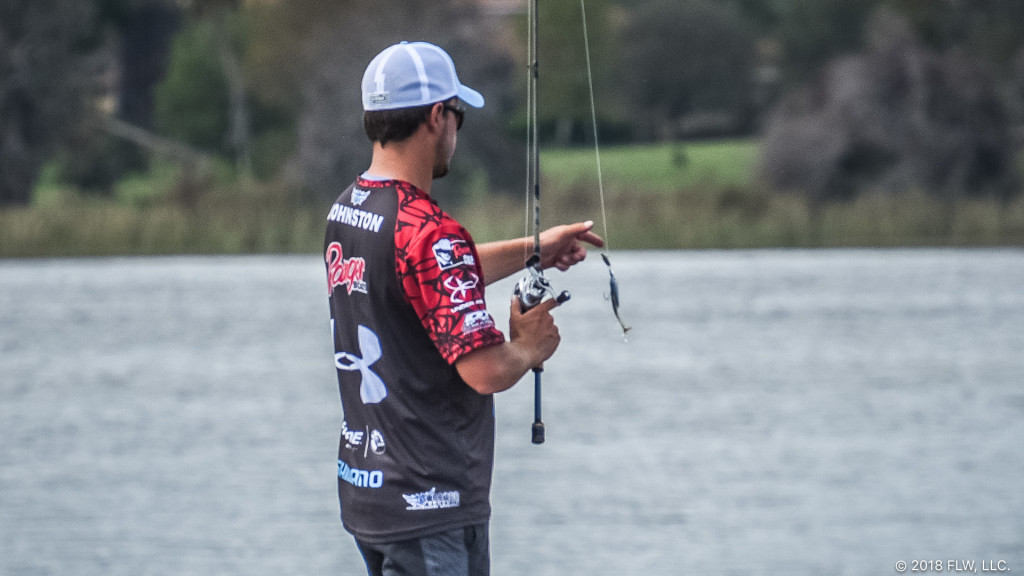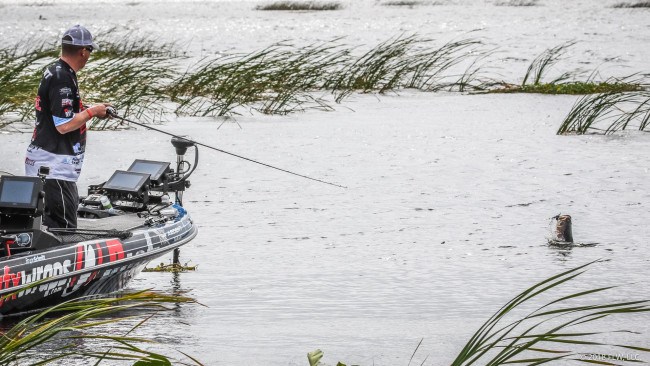Vibrating Jigs Redux
How today’s top pros get the most from a ChatterBait

Four years ago FLW featured an article with then-FLW Tour pro Brett Hite about how he fishes vibrating jigs – the ins and outs, dos and don’ts. It’s a solid article that could set pretty much anyone up for success with the lures.
Yet, something interesting has happened at the first two stops of the 2018 FLW Tour season. Vibrating jigs have been in the arsenals of pretty much everyone, including most pros in the top 10 and both winners. That, in itself, is not surprising, as a vibrating jig is popular in Florida, where the first two tournaments were held. The interesting part is how certain guys, such as Tim Frederick, Chris Johnston, Jeff Gustafson and Bryan Schmitt, outfished everyone else using the same lure. While watching them on the water, it became clear they were doing things differently.
That’s a good enough reason to look back, update and expand that article from a few years ago.

Any season + reaction = big bass
Vibrating jigs are ideal prespawn lures. That much was established in the first article, and still holds true.
Yet, Frederick, Schmitt and Johnston all were targeting not just prespawn fish with vibrating jigs at the Tour’s opener on Lake Okeechobee, but also spawning fish. How? By slowing way down.
“As that tournament went on, I started to feel like the fish were on beds,” says Schmitt, who finished second at Okeechobee. “Those beds were in holes in the grass. So you’d be reeling, hit the grass and then there would be an open spot. The slower I reeled, the longer it was in that open spot to annoy a bedding female.”
In watching on the water, it was clear these pros were all keyed in on the same thing, reeling far slower than the sometimes 30 other pros around them also throwing vibrating jigs.
However, a month later, Johnston won at the Harris Chain by incorporating a vibrating jig and keying in on a postspawn pattern: the shad spawn. Again, Johnston was fishing it slowly, which is his typical technique for keeping the vibrating jig in contact with cover or close to the bottom. But because the water he was fishing was in the 10- to 12-foot range, he didn’t feel he could reel slow enough to keep his vibrating jig down. The solution?
“I’d let it sink to the bottom, and then I would yo-yo it,” says Johnston. “They’d smoke it every time I’d kill it.”
Gustafson, who finished runner-up at Harris, used a similar technique – ripping the bait in open holes to draw a reaction strike in spots where there wasn’t any grass to make contact with.
Spring is a peak time to throw a vibrating jig, but Schmitt and Johnston say they’ll also throw vibrating jigs year round, usually around grass, but not always.
“I’ve used it on shallow ledges at Kentucky Lake and Pickwick in the summer, letting it sink to the bottom and yo-yoing it,” says Johnston. “It’s pretty effective.”

The right equipment
Hite’s advice in the original article was to use fluorocarbon line in combination with a fiberglass rod, suggesting that the more moderate rod action helped achieve the best bait action and slow reaction time to help your hookup ratio.
Schmitt agrees with that strategy to an extent.
“You definitely want to give the fish a split second before setting the hook, especially with braid,” says Schmitt, who mainly uses 15-pound-test fluorocarbon but utilizes braid when he wants to get “noticeable” extra vibration from the blade. “Braid is so sensitive you’ll often actually feel the fish pushing water up to eat it. You’ll pull the lure right away from it if you don’t allow the rod to load up before setting the hook.”
However, Johnston and Schmitt both use graphite rods – a 7-foot, 2-inch or 7-foot, 5-inch, medium-action for Johnston, who likes that length for “extra leverage,” and a 6-foot, 9-inch to 7-foot, med-heavy for Schmitt. The reason for Schmitt’s shorter rod choice is he tends to work his vibrating jig more like a jerkbait and often makes precise casts to pieces of cover.
“I’m always twitching and popping a vibrating jig,” he explains. “I always tell myself a fish is following it, and I’m trying to get a reaction by popping it, even if I’m not hitting cover.”

Even more-specific specifics
Hite suggested a three-color, three-trailer game plan for matching just about any common forage. His choices were green pumpkin with a black blade, black/blue with a black blade and white/chartreuse with a silver blade. Schmitt and Johnston, along with most Tour pros, use the same basic strategy.
The black/blue combo is the go-to for Johnston and Schmitt the majority of the time. Green pumpkin gets the nod if they feel the fish are keying on bluegills or they’re fishing clearer water. A shad color really only gets the call when they know the fish are specifically keying on shad, like what happened at the Harris Chain.
This is in reference to the skirt color, not the blade. Blade color has become quite a sticking point for many anglers, with many saying they won’t throw a vibrating jig unless it has a black blade, while others prefer silver. Neither Schmitt nor Johnston puts too much emphasis on blade color, but each says it can make a difference.
Former FLW Tour pro Wesley Strader reported just such a situation at the 2017 Potomac River event. He and his co-angler were throwing black/blue vibrating jigs. Strader’s had a black blade, and the co’s had a silver blade. Strader couldn’t seem to get bit, while the co-angler was culling constantly. The situation suggests that if you’re not having the success you expect, consider swapping the blade color to see if the change makes a difference.
Hite also reported a three-trailer system: craw, paddle-tail swimbait and shad silhouette. Again, all shine at key times. Sometimes the best strategy is to match the preferred local forage, but usually you have to experiment to figure out which one is the best choice.
“If I’m really lucky and find a school of fish in practice I know won’t help me during a tournament, I’ll use them to play with trailers,” says Schmitt. “They’ll almost always key you in on one that’s outperforming the others.”
Schmitt typically starts with a Missile Baits Twin Turbo double-tail grub or Baby D Bomb creature bait.
“That’s the Potomac in me,” says Schmitt. “I like the extra thump, and the fish eat a lot of crayfish year round there. I’ve seen crayfish crawling all over the tops of the weeds in the middle of summer.”
For Johnston, the first choice is a Jackall Rhythm Wave 4.8 paddle-tail swimbait for its big profile, which he believes can get bites from bigger fish.
Those are their confidence baits, but they both agree that if there’s one universal trailer option, it’s the shad silhouette. Some favorites from around the Tour include the Yamamoto Zako and a Zoom Salty Super Fluke.
In the end, color and trailer choice come down to confidence, but it’s important to remain willing to experiment, which is often what it takes to turn a solid bite into a great one. And that’s what it sometimes takes to fully unlock the potential of the vibrating jig as one of spring’s best go-to reaction baits.